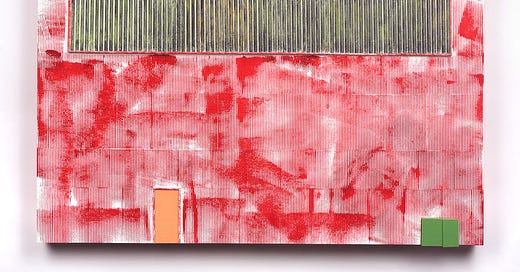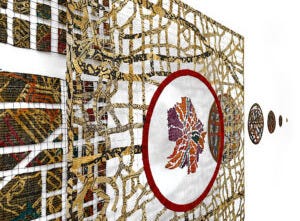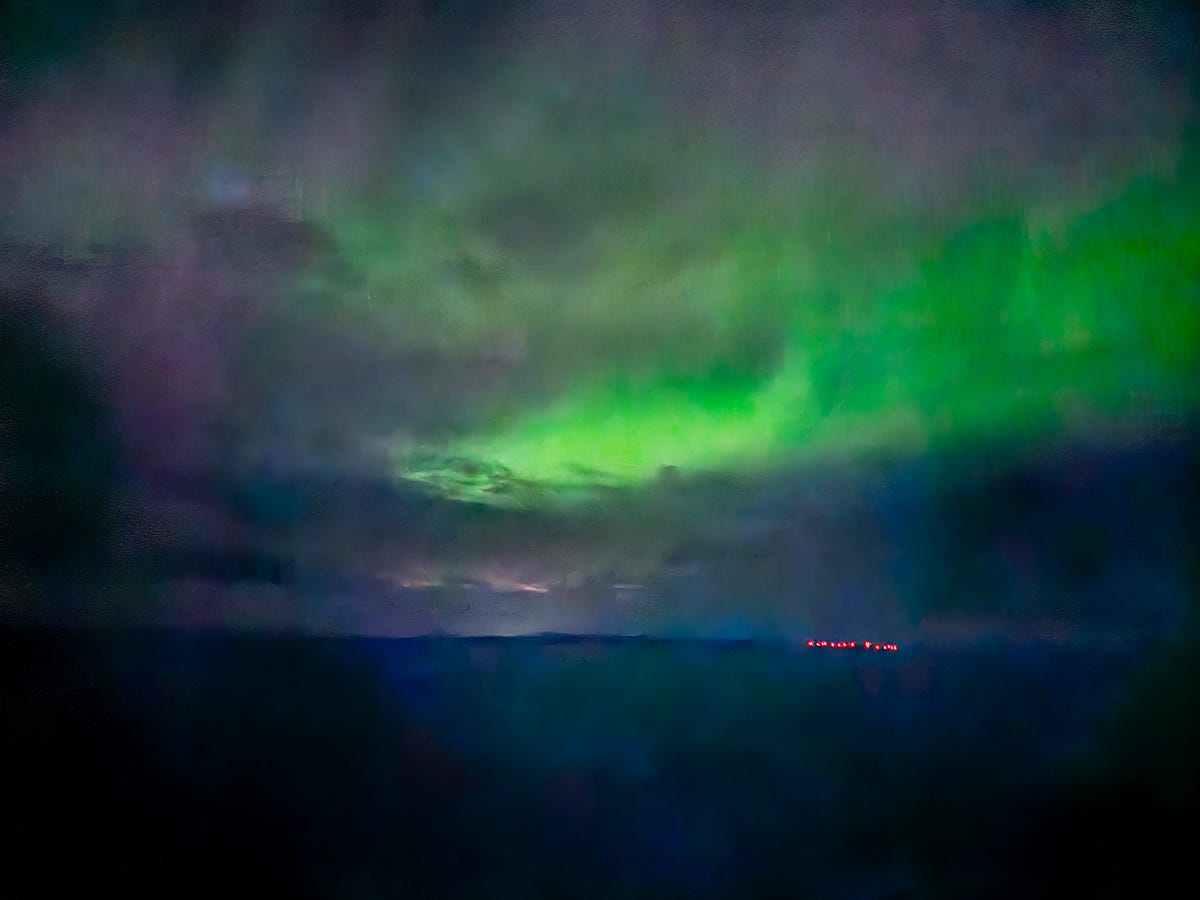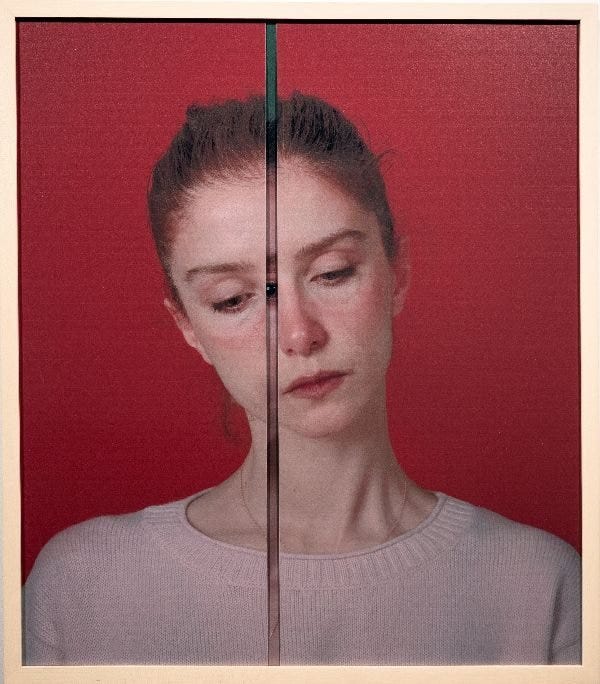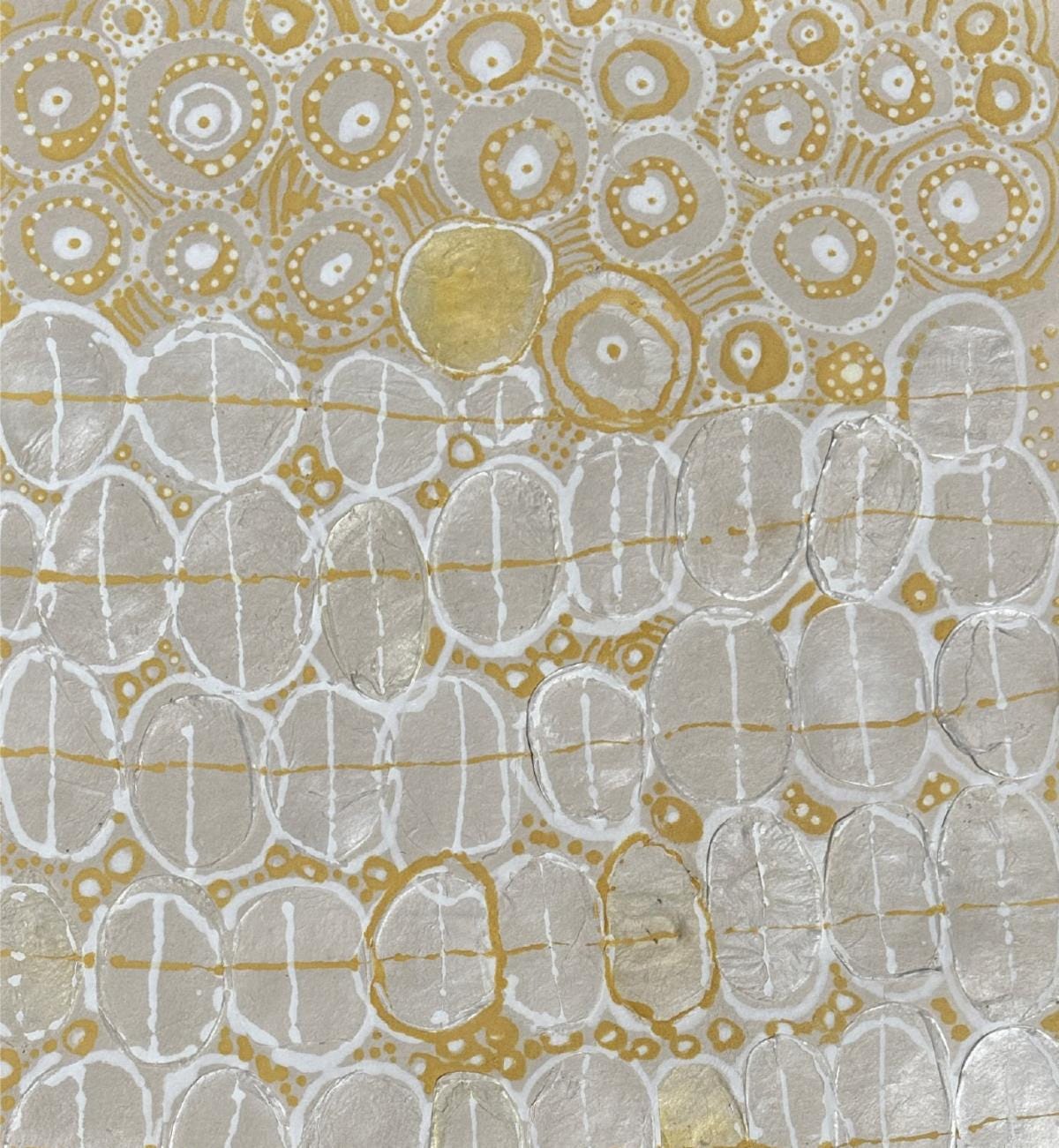Senses of Places
Work by Marie Ringwald, Eszter Bornemisza, Hosna Shahramipoor, Elsabe Dixon, Sharon Fishel, Roderick Turner, and the Multiple Exposures photographers
Marie Ringwald, "Big Red Warehouse with a Large Vent and an Orange Door" (courtesy of the artist)
VETERAN D.C ARTIST MARIE RINGWALD HAS LONG WORKED VARIATIONS on an archetypal form. Her choice is not a line, a circle, or a triangle, but something with many more associations: a simple utilitarian structure such as a shed, barn, or warehouse. In "New, Old + Borrowed," this building is distilled and streamlined, but given real-world presence by complex textures.
At their simplest, the two-dimensional works in Ringwald's Fred Schnider Gallery of Art show are stripe paintings contained in outlines defined by walls, roofs and chimneys. These images summon twin recognitions -- as hard-edged abstractions and as distillations of the buildings all around us. Gently mottled colors invoke the process of laying down paint while also evoking well-worn facades.
The archetypal edifices are further complicated when the artist extrapolates them into sculptures, whether wall-mounted or free-standing. Sitting on pedestals, five of "The Pinks" offer eccentrically slumping shapes and powerful contrasts between black and the title color. Closer to their architectural models are the flattened 3D sculptures, their blank horizontal surfaces interrupted by such everyday features as doors, windows, and a white picket fence. In "Big Red Warehouse with a Large Vent and an Orange Door," the two simple portals are significant enough to merit mentions in the title, but the assemblage's most vivid aspect is the imperfect way red pigment adheres to the facade's ribbed panels.
The red warehouse is one of four pieces whose basis is an image by a credited photographer. Another is a rendering of a black quonset hut, a temporary structure erected during the Vietnam War. The latter comes as a surprise, since its specific location trumps its generic shape to summon poignant memories. It seems that Ringwald values buildings not just as paradigmatic forms, but also as containers of unruly thoughts.
Eszter Bornemisza, “Nowhere” (IA&A at Hillyer)
JUST A FEW BLOCKS FROM ONE OF PIERRE "PETER" L'ENFANT'S largest traffic circles, Eszter Bornemisza has mounted an exhibition the French-born city planner might have appreciated. The Budapest artist is not literally a cartographer, but the influence of European urban geography is evident in her IA&A at Hillyer show, "You Are Here?" This array of 3D abstractions, made mostly of recycled newsprint that's painted and sewn, evokes streets, alleys, and roundabouts.
Placed on the floor, Bornemisza's creations might function like labyrinths. But they're mounted on the walls, where they suggest both actual thoroughfares through a city and symbolic routes through life. Most of her pieces are layered, so the eye can travel in many directions, whether across or into the intricate profusion of see-through grids and circles, the latter often concentric. All the symbolic maps, whether single- or multi-ply, are hung away from the wall, so they cast shadows that intriguingly entangle the patterns.
Trained as a mathematician and self-taught as a fiber artist, Bornemisza is concerned with memory, identity, and belonging, according to her statement. But the context of her quest is specifically urban. The experience she conjures is of world that's man-made and historic. Paper and thread equal brick and stone, and all the possible paths through this conjectural environment seem to have been walked for centuries.
Francine B. Livaditis, "Northern Lights" (Multiple Exposures Gallery)
THE GLIMMERS CAPTURED IN MULTIPLE EXPOSURES GALLERY'S CURRENT SHOW delineate specific places, of course. But illumination itself is often the primary focus of "Luminous." The 12 participants are intent on "transforming light into the subject," notes curator Christa Dix's statement.
About half the 20 pictures are in color, but few are as vividly hued as Francine B. Livaditis's "Northern Lights," in which electric greens disrupt a blue-black night sky, and are set off by tiny red lights strung along the horizon. Hot white, yellow, and orange burn at the center of Sarah Hood Salomon's near-abstract "The Morning After She Died." More typical of the color shots are Fred Zafran's "Curios," whose barely distinguishable figure stands in a darkened room brightened only slightly by sunlight through stained-glass windows; Tom Sliter's "Table Berg," an icy ocean scene rendered in grays, white, and pale blue; and Stacy Smith Evans's "Three Travelers," in which silhouetted black legs cast equally black shadows on a small section of floor turned glossy gold by an unseen light source.
Luminosity is essential to photographic images, but this show could just as reasonably be titled "Shadows" or "Ghosts." The compositions, often chiaroscuro, capture the mystery of things and people largely swathed in blackness. Such scenes can be as orderly as Eric Johnson's "Dumser's Dairyland," in which people spin around a well-lighted ice-cream stand like asteroids around a star; or as feral as David Myers's "Heat of the Afternoon," in which three walkers in the distance appear about to be swallowed by mist and shade. Stepping into the light has its appeal, but so does vanishing into the darkness.
Hosna Shahramipoor, “Duality” (D.C. Arts Center)
THE SELFIE BECOMES A FORM OF CONFESSIONAL in Hosna Shahramipoor's D.C. Arts Center exhibition. The Washington artist, who in 2017 emigrated from Tehran to the U.S., transforms photographic self-portraits into semi-sculptural meditations. The show is titled "in." because many of the wood-based pieces involve a sort of psychic surgery. The images are opened up -- split, carved, or ripped -- to suggest a personality that -- like everyone's -- is fractured.
Some of the incisions may indicate the divides that come from being Persian (the artist's term) in a foreign and not always friendly land. But the show, which was curated by Briget Heidmous, illustrates other kinds of fissures. A portrait in which Shahramipoor reveals her pregnant belly is partly ripped open, hinting at both physical pain and a psychological void. "Duality" splits the artist's face vertically, leaving a narrow gap through which a flicker of her submerged eye peers out alarmingly.
Not all the scenarios are autobiographical. The artist poses as an Iranian everywoman, boldly displaying her hair while most of her face is covered in masking tape. In "a Cut through," a nose-less Shahramipoor plays the role of Bibi Aisha, the Afghan woman whose nose was cut off by her brother-in-law when she attempted to leave her abusive husband.
With perhaps-intentional irony, such intimations of chaos are carefully controlled. The artist's visage appears unruffled and even serene in these pictures, and the sculptural elements are elegantly built. While Shahramipoor portrays both psychological and political turmoil, the forms and surfaces of her artworks are immaculately governed.
Elsabe Dixon, “Sericulture Notes and Insect Interactions” (detail) (The Athenaeum)
NATURE AND THE HUMAN DESIGNS THAT EMULATE IT are what links the "Embodied Transformations" of Elsabe Dixon and Sharon Fishel. The collage-paintings in the local artists's Athenaeum show are built from such things as beeswax, flower petals, worm-spun silk, and spotted-lanternfly wings. These artifacts of the natural world are tenderly guided to depict that transient realm.
Parts of Fishel's pictures are heavily painted, and patches of deep color are sometimes punctuated with embossed-like forms in lighter hues. Yet her work often feels gauzy, and its repeated floral motifs suggest printed fabrics. The yellow pattern atop the predominantly blue-green backdrop in the intricate "How Many Springs?" is elegantly lacy, and appears to float in air like a globe-shaped lantern. Among the delicate things Fishel evokes, none is filmier than light itself.
More expansive in ingredients, if not imagery, Dixon's mixed-media works draw from insects both essential (bees) and invasive (that notorious lanternfly). In addition to color and shape, Dixon's earth-toned pictures offer the beguiling aroma of beeswax and the immersive effect of dozens of similar, though decidedly not identical, forms. By directing the eye toward found patterns and raw textures, Dixon makes the universe of insects appear fundamentally immense.
FOR LOCAL PAINTER RODERICK TURNER, "LIFE IN D.C." encompasses just two quadrants, Southeast and Southwest -- and some glimpses of distant Maryland and Virginia, reduced to soft hills or hazy skylines. That means his realist oil paintings don't depict the city's most conspicuous landmarks. Yet Turner doesn't train his eye on hardscrabble neighborhoods or funky street scenes, and his account of gentrification is indirect.
Most of the landscapes in his Honfleur Gallery show (a version of which was exhibited at Foundry Gallery last year) are widescreen views, emphasizing how Southeast's modest houses -- some of them brand new -- nestle into their hilly environs. The pictures tend to be horizontal, sometimes extremely so, to capture the sweep of the area's rolling terrain.
When Turner crosses to the western side of South Capitol Street, both his subjects and style change. The artist's pictures of Southwest portray small boats and a tall ship, rendered with more detail than his Southeast scenes. But the Monet-inspired artist doesn't entirely abandon the soft brushstrokes of his eastside paintings. Such gestures remain, but delegated to backdrops, such as cherry blossoms across the channel or the complex play of light on water. Turner's part of D.C. is a place where every dab is quietly enchanted.
Marie Ringwald: New, Old + Borrowed
Through June 28 at Fred Schnider Gallery of Art, 888 N. Quincy St., Arlington. fredschnidergalleryofart.com. 703-841-9404.
Eszter Bornemisza: You Are Here?
Through June 29 at IA&A at Hillyer, 9 Hillyer Court NW. athillyer.org; (202) 338-0680.
Luminous
Through June 29 at Multiple Exposures Gallery, Torpedo Factory, 105 N. Union St., Alexandria. multipleexposuresgallery.com; 703-683-2205.
Hosna Shahramipoor: in.
Through June 29 at D.C. Arts Center, 2438 18th St. NW. dcartscenter.org. 202- 462-7833.
Elsabe Dixon & Sharon Fishel: Embodied Transformations
Through June 29 at the Athenaeum, 201 Prince St., Alexandria. nvfaa.org. 703- 548-0035.
Roderick Turner: Life In D.C.
Through June 28 at Honfleur Gallery, 1241 Marion Barry Ave. SE. honfleurgallerydc.com. 202-631-6291.

